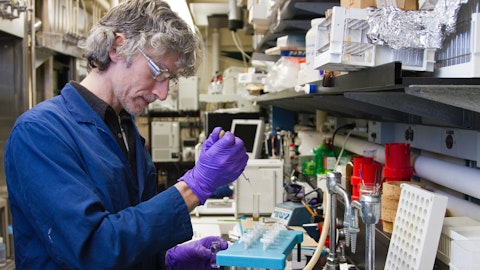Toyota Motor Corporation (NYSE:TM) Q4 2023 Earnings Call Transcript May 10, 2023
Ellie Gibbs: Ladies and gentlemen, thank you very much for coming today. We would now like to start the financial results meeting for the year ended March 2023. My name is Ellie from Public Relations, and I will be the MC for today’s meeting. Before we announce the financial results, Koji Sato, our President, has a few words to mention. Mr. Sato, please.
Koji Sato: I am Koji Sato. Before announcing our financial results, I would like to explain the current situation regarding the Daihatsu procedure realities issue, which was announced on April 28. Since the announcement, we have had an independent third-party review entity conductor retest of those vehicles concerned. It has once again been confirmed that the vehicles concerned present no quality or safety issues. Based on the results of the retest and as to consulting with the related authorities, we have resumed shipments of the Toyota brand vehicles to Malaysia, Mexico and Ecuador. As for Thailand and Middle Eastern countries, we will continue to consult with the related authorities. The day before yesterday, Chairman, Toyoda visited Thailand to explain to our customers and stakeholders what had happened and to convey to them that the vehicles were safe and that our entire corporate group was committed to working to prevent this type of misconduct from ever happening again.
Daihatsu and Toyota are confirming the fact from various perspectives to prevent a recurrence. Toyota is a company in which all members always stop when a problem occurs. It pursues a root cause of problems by going and seeing the location of process where the problem exists, mix improvements and works to prevent recurrences. We will continue to investigate the root cause, believing that it is important to change the environment in which such misconduct occurs. We will keep you informed as and when progress is made.
Ellie Gibbs: Thank you. Now we would like to call upon Yoichi Miyazaki, the Executive Vice President and Chief Financial Officer, to explain about the financial results.
Yoichi Miyazaki: I’m Miyazaki, the CFO, and this is the first time I take the coding, this title, I hope you bear with me. Before sharing you the financial results, we would like to express our heart felt appreciation to our customers around the world who choose as well as our shareholders, our dealers and suppliers and all other stakeholders who support us in daily activity. Thank you so very kindly. So let me provide a summary of the financial performance of the fiscal year ending March 2023. While we experienced production constraints due to tight semiconductor supplies, natural disasters and COVID-19, et cetera, dealers and suppliers as well as production sites have all worked hard in order to deliver as many cars as possible to our customers.

GongTo / Shutterstock.com
In spite of our actual operating income decreasing compared to the last fiscal year due to the impact of such things as soaring material prices, our results exceeded the previous forecast due to our continuous efforts to improve our profit structure. For the forecast for the next fiscal year, we expect production volume of 10.1 million and sales volume increased in all regions as a result of such things as improvements in semiconductor supply and the efforts of production sites. We will continue to both advance our activities towards carbon neutrality and improve our product structure. Also without slowing down our growth investments, we will promote activities to change the future of our cars. In terms of return to shareholders, in order to reward our long-term shareholders, we have a new dividend policy to increase dividends stably and continuously.
We have placed more focus on dividends for our shareholder returns, and the year-end dividend will be JPY35 per share, which is an increase of JPY7 compared to the previous fiscal year. The total dividend will be JPY60 per share, which is an increase of JPY8 from the previous fiscal year. As for the share repurchases under our policy to conduct flexibly taking into account our share price levels, et cetera for our year-end repurchases, we will proceed with a maximum of JPY150 billion, which is equivalent to our interim repurchases. Now then let me explain the summary of our performances for the fiscal year ended March 2023. Consolidated vehicle sales for the period was at 8,822,000 units, which was 107.2% of such sales over the previous fiscal year.
Toyota and Lexus brand vehicle sales was at 9,610,000 units, which was 101% of such sales in the previous fiscal year. So as for the vehicles sales by region, we saw an increase in all regions compared to the previous fiscal year. Also, the ratio of electrified vehicles became 29.6%. Consolidated financial results were sales revenue of JPY37,154.2 billion, operating income of JPY2,725 billion. Income before income taxes JPY3,668.7 billion and net income of JPY2,451.3 billion. Now I’d like to explain the factors which impacted operating income year-on-year. First, the effect of foreign exchange rates increased operating income by JPY1,280 billion. Second, cost reduction, of course, decreased operating income by JPY1,290 billion, the JPY1,545 billion impact of soaring material prices includes JPY500 billion for activities aimed at strengthening the structure of the entire supply chain in addition to fluctuations in market conditions for materials.
Third, marketing efforts increased operating income by JPY680 billion. Fourth, increase in expenses decreased operating income by JPY525 billion. Lastly, we also incurred a negative impact of JPY415.6 billion largely due to the swap valuation losses and the cost to terminate our production in Russia. As a result, excluding the overall impact of foreign exchange rates, swap valuation gains and losses and other factors, operating income decreased by JPY1,135 billion year-on-year. Now let me explain the operating income for each region. Japan increased by JPY477 billion year-on-year due to the effects of foreign exchange rates despite the negative effect from soaring material prices. North America decreased by JPY457.8 billion year-on-year due to soaring material prices.
Going forward, Europe also decreased by JPY115 billion year-on-year due to soaring material prices and the cost to terminate our production in Russia despite the positive effect from our marketing efforts. Asia increased by JPY55.7 billion year-on-year due to the effect of foreign exchange rates and increase in sales volume. Other regions increased by JPY36.7 billion year-on-year. In the next slide, let me explain about our business in China as well as our financial service business. As for our business in China, while the operating income of consolidated subsidiaries decreased year-on-year, mainly due to the impact of fluctuations in foreign exchange rates and a decrease in sales volume, our share of profit of investments accounted for using the equity method increased year-on-year, mainly due to cost reduction efforts.
Regarding the Financial Services business, operating income for the fiscal year increased year-on-year due to the impact of fluctuations in foreign exchange rates. Next, I’d like to explain about our return to shareholders. In order to reward our long-term shareholders, we have eliminated our conventional guideline of consolidated dividend payout ratio of 30%. Instead, we have revised our policy to increase dividends steadily and continuously. So as we have more focus on dividends. The year-end dividend for the current fiscal year will be JPY35 per share, which is an increase of JPY7 compared to the previous fiscal year. Together with the interim dividend of JPY25, the total full year dividends for this fiscal year are JPY60 per share, which is an increase of JPY8 from the previous fiscal year.
Previously, we have conducted share repurchases based on factors such as investment in growth, dividend levels and cash on hand. However, we have revised our policy to conduct flexibly taking into account our share price levels, et cetera. For year-end repurchases, considering the current share price level, we set aside JPY150 billion as the maximum limit of year-end repurchase, which is equivalent to our interim. Next, I will explain the forecast for the fiscal year ended March 31, 2024. First of all, I will explain the production volume forecast for the Toyota and Lexus brands. We expect 10.1 million units, which is 110.6% of the previous fiscal year. The reason behind the increase in production forecast for the previous fiscal year is as follows.
We have been working on examination of alternatives regarding them in light of supply risks in the future as well as on promoting improvements aimed at improving operating rates at factories. Since March, we have been able to continue high level production while prioritizing safety and quality. At sales sites in each region, the production volume still cannot keep up with customer demand. So we will continue to promote improvements together with our suppliers in order to further increase the production volume. We expect consolidated vehicle sales of 9,600,000 units, which is 108.8% compared to the previous fiscal year. As the semiconductor supply and demand has improved, we expect growth in all regions. As for Toyota and Lexus brand vehicle sales, we expect 10,400,000 units, which is 108.2% compared to the previous fiscal year.
We expect electrified vehicle sales of 3,843,000 units, which is 134.9% compared to the previous fiscal year, and the electrified vehicles ratio is expected to be 37.0%. Next, I will explain the forecast for the fiscal year ending March 31, 2024. We have adopted the full year foreign exchange rate assumption of JPY125 per U.S. dollar and JPY135 per euro. Based on this, our forecast for full year consolidated financial performance are: sales revenue of JPY38 trillion, operating income of JPY3 trillion income before income taxes of JPY3,690 billion and net income of JPY2,580 billion. Next, I would like to explain the factors that may impact operating income. First, the effects of foreign exchange rates will decrease the operating income by JPY875 billion.
Second, the cost reduction efforts are expected to increase profit by JPY360 billion, while the impact of decreasing material is expected to be JPY510 billion, resulting in a total decrease JPY150 billion. Third, the effects of marketing activities will increase the operating income by JPY1,285 billion due to an increase in sales volume and an improvement in product mix, led by improved semiconductor supply and demand, while other expenses are expected to decrease by JPY260 billion. Compared with the pre-closed fiscal year ended March 31, 2020, we became able to offset the impact of soaring material cost to GPS cost reductions and marketing efforts as a result of our long-standing product centered and region centered approach. We have also established a foundation for steadily increasing growth investments.
We live in an era where there is no right answer and the future is uncertain. So we will always keep our antennas up and carefully manage risks in preparation for changes in the business environment. This brings us to the end of our presentation. Thank you very much.
Ellie Gibbs: Thank you. We’d now like to ask our President, Koji Sato, to take the floor again.
See also 13 Best Communication Services Stocks To Invest In and Warren Buffett’s $5.7 Billion Dividend Portfolio: Top 15 Picks.
Q&A Session
Follow Toyota Motor Corp (NYSE:TM)
Follow Toyota Motor Corp (NYSE:TM)
Koji Sato: Once again, I am Koji Sato. As Miyazaki-san just mentioned, despite the severe business environment, including soaring material prices, we were able to secure an operating profit of JPY2.7 trillion in the previous fiscal year. Our new management team assumed the reins on April 1. However, the financial results figures for the previous fiscal year were based on the 14 years of former President, Akio Toyoda’s efforts, making me once again keenly aware that our change in management took place while Toyota was being managed at top speed. As such, our new management team will be able to focus on strategic initiatives in growth areas based on this current foundation. When Chairman, Toyoda took office as President, he said growth is about being able to continuously change ourselves in response to ever-changing needs of customers and society.
And I believe that his 14 years as President embodied exactly that. Now that he is Chairman, he is in a position to support our new management team, and we will implement a new form of team management with the Chairman and President working simultaneously and according to an optimal division of rules at any given time. Our team will take advantage of this environment to promote speedy management. With that in mind, I would like to once again talk about our future management. I believe that the growth Toyota should aim for going forward is growth that creates a future in which the automobile industry transforms itself into a mobility industry through enhancing its added value as it works in cooperation with many other industries. The foundation for this is carbon neutrality.
Toyota aims to reduce new vehicle CO2 emissions by more than 50% globally by 2035. To achieve this, we will continue to provide regionally optimal solutions at an accelerated pace without wavering from our multi-pathway approach. When it comes to battery electric vehicles or BEVs, which are especially rapidly progressing, we have set a pace of selling 1.5 million units by 2026 as our base volume, and we plan to launch 10 models ranging from luxury vehicles to compacts and commercial vehicles, mainly in the United States and China. Regarding the battery supply, we will seek to speedily secure the necessary volume by increasing our in-house production capacity and collaborating with our partners. Our new model scheduled for launch in 2026 will be built on 3 new platforms, the body and chassis, the electronic platform and the software platform.
They will all be renewed as we aim to achieve mobility by the way of renewed vehicle packaging with a rational structure that is unique to BEVs. From now on, with a new dedicated organization, BEV factory will lead the initiatives and the initiatives will be accelerated. We would like to present concept for vehicles of such at the Japan Mobility Show this autumn. At the same time, as our BEV initiatives, we will also accelerate our efforts to realize the hydrogen society. We will advance our projects in the commercial domain, especially in Europe and China where hydrogen consumption is particularly high centered on fuel cell electric vehicles. Furthermore, we will focus on the use of hydrogen energy for personal mobility and on the cycle of producing, transporting and using hydrogen and we will conduct activities for the development of social infrastructure, including through social implementation in Thailand.
To actively promote these initiatives, we will also increase our immediate earning power especially in Asia and emerging markets, which are expected to grow 30% or more by 2030. We will strengthen our earnings base by focusing on hybrid electric vehicles to capture market growth. To transform automobiles into our mobility industry, we will further increase our current approximately JPY3 trillion in R&D expenditures and capital investment while increasing the ratio of future investment to achieve sustainable growth. Thank you for your kind attention.





